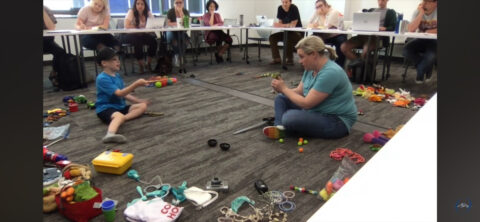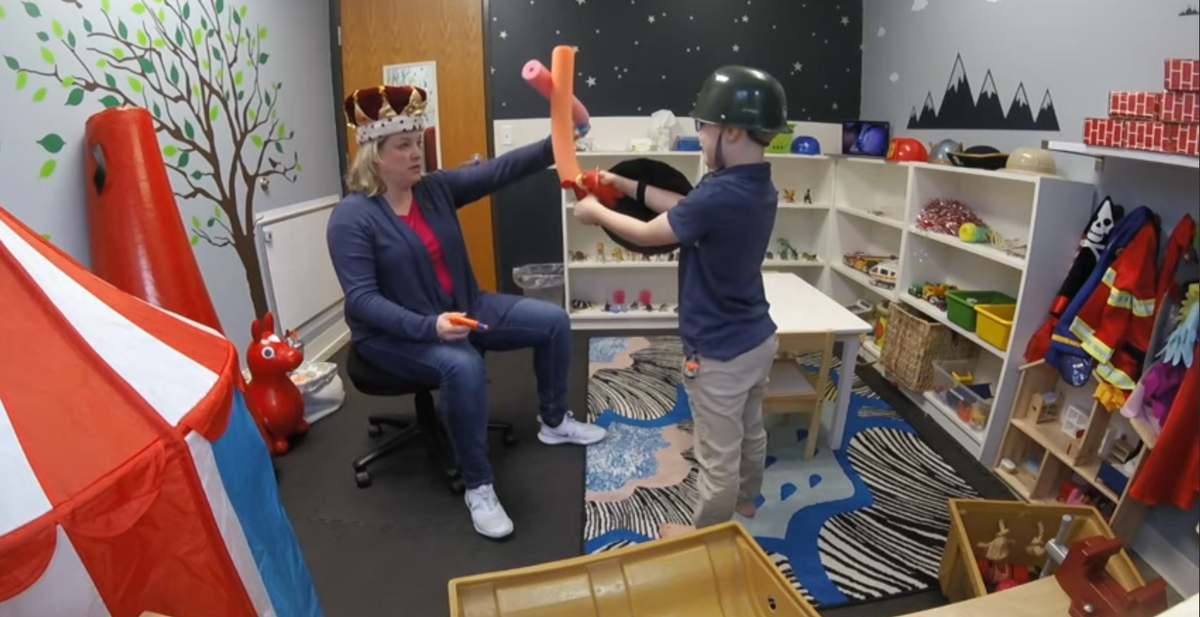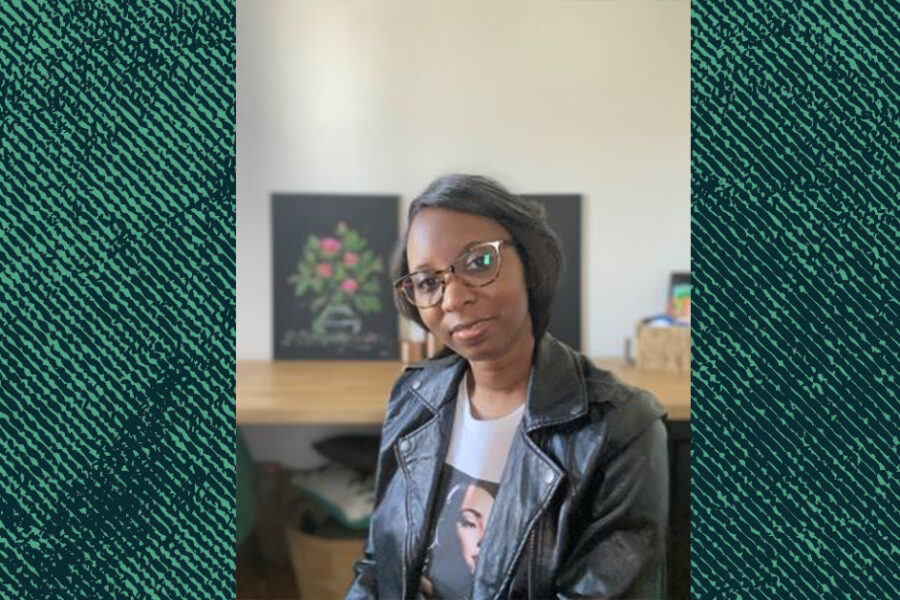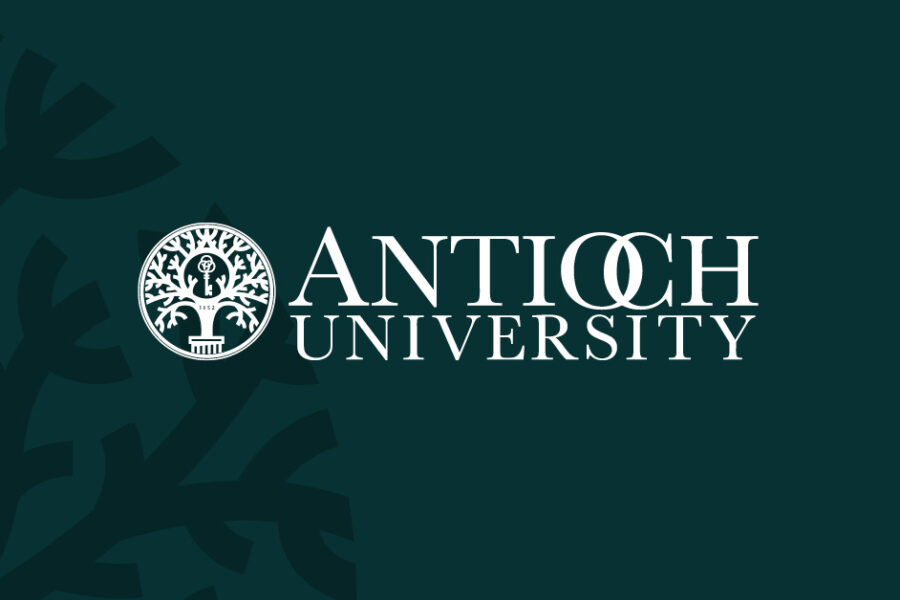When the word “play” comes to mind, many recall childhood memories of games with friends, days of outside exploration, or time spent in imaginative worlds. As we become adults, however, the idea of spending time just playing often morphs into a forgotten activity we are too busy and too serious to engage in. But is play reserved for children and the nostalgic memories of those who once were? For Cary Hamilton, director of Antioch Seattle’s Certificate in Play Therapy Certificate, play is non-negotiable for our wellbeing across the lifespan. “The general public,” she says, “believe that play is kind of the superficial, unimportant thing for humans to do—when in actuality it’s required for our health to be playing.”

One of the most exciting classes offered within the Play Therapy Certificate program Hamilton runs is “Sandtray Play Therapy Seminar.” In this class, students learn about the use of sandtray in play therapy, a practice in which a client uses figurines or other miniature toys to create dioramas on a large tray of sand. This allows for clients to work through internal feelings and experiences through play, rather than traditional talk therapy methods. Among the many different techniques and approaches within the field of play therapy, sandtray implementations in particular have garnered significant interest within the general public. As Hamilton explains, “‘Sandtray’ is the one that everyone wants to talk about.”
Partly, this is because sandtray is charismatic to watch. “On the Seattle campus, the room that we always have is all glass windows,” she says. “So when we’re doing sandtray, it’s like all of the sparkling white sand and toys and everyone walking by wants to come in and see.”
The Therapeutic Power of Toys and Sand
The entirety of the play therapy certificate program highlights the importance of developmentally appropriate interventions. One alum of “Sandtray Play Therapy Seminar,” Amy Pittman, says that the Play Therapy Certificate program has made her a “rockstar” in clinical practice and coursework. Pittman has studied play therapy at Antioch concurrently with pursuing a Master of Counseling from Northwestern University, and she says, “What I noticed almost immediately was how my case conceptualizations changed and were different from my colleagues in school.”
For Hamilton, this isn’t a surprise. She says that sandtray therapy can be a powerful approach, because clients “can play out their narratives, they can have validation, they can rewrite the stories and the narratives in their brain using play.” While play therapy itself is designed for all ages across the lifespan, sandtray is implemented in therapy as early as elementary school, when, Hamilton explains, “there is the ability to have abstract thought.”
While many mental health professionals are quick to apply skills-based interventions or talk therapy methods perhaps better suited to adult clients, Hamilton trains clinicians on the importance of client-centered work across the lifespan. Hamilton says, “I cringe when everybody’s trying to use talk therapy with an eight year old, because biologically, that’s inappropriate to be doing. Which means, don’t talk at children, play with them instead.”
A Community of Play

Another benefit of Antioch’s Play Therapy Certificate is connection. Students come from different geographic locations to form a community of lifelong professional networking and support. The formulation and eventual dynamics of a play therapy cohort are a big part of what makes the learning environment special. “Because you learn to fail and make mistakes, you have all these realizations,” she says. “And play inevitably is vulnerable, right?”
Within this vulnerability comes a process reflective of play therapy. As Hamilton puts it, “We get silly and goofy in play, and inevitably, the other stuff comes out, which is often what happens in sandtray.”
Another alum of the Play Therapy Certificate, Alexandria Scalone, describes how it was this community of mutual vulnerability, risk-taking, and play that “revolutionized” her clinical practice. “This transformative experience not only deepened my understanding of therapeutic models but also reshaped my approach to healing,” she says. She combined her study of play therapy with work in the MA in Couple and Family Therapy program, and it was a potent combination. “I cannot overstate the profound impact the play therapy program has had on my professional journey.”
From the Classroom to the Therapy Room
Hamilton herself approaches the Play Therapy Certificate program with decades of firsthand experience and practice. She has maintained two decades of membership with the Association for Play Therapy and even served as President of the Washington Association for Play Therapy, in both 2015 and 2022. She has also practiced play therapy internationally, during work trips in China, Italy, and Kenya. Despite traditional language barriers, Hamilton explains that spoken word is not entirely necessary when play is involved. This, she says, demonstrates how play therapy is inherently a multicultural and socially just modality.
These strengths of play therapy extend beyond young clients. Another interest of both Hamilton and her students revolves around the application of play therapy with adults—particularly military and veteran communities. Sandtray has proven to be an especially powerful tool for therapeutic change and reflection among military clients.
“Sandtray affords us the ability to engage with soldiers in a way that they don’t have to use talk therapy to talk but they can get their experiential, kinesthetic needs met,” Hamilton says. “I’ve had lots of colonels in my office where they’re like, ‘I need to talk but I can’t talk and I don’t know how this will work.’” Whether it is a result of confidentiality concerns or trauma, sandtray and play has allowed military clients to engage fully in therapy.”
Alumni of the play therapy certificate program also have found a professional home working with military populations. This is the case for Gladys Lopez, an MA in Clinical Mental Health Counseling alum, who says, “I currently work within the military community, and I use the skills I learned to impact how mental health and counseling is perceived by this community.” To that end, Lopez says, “I plan to continue to expand my skills and become a registered Play Therapist!”
Meeting Needs of the Pacific Northwest and Beyond
Whether graduates of the program choose to work with adult or child populations, there is a great need for play therapists, especially after the pandemic exacerbated the shortage of mental health providers nationwide. This is a problem for those seeking mental health treatment, but it is also an opportunity for new therapists to build thriving businesses.
Julie Brenneise, an alum of the Clinical Mental Health Counseling program who pursued the Play Therapy Certificate as part of her studies reports that she has had little difficulty in building up a private practice. “Due to the pandemic, the field is very low on child therapists right now, and my play therapy training helps me stand out from other child therapists,” she says. She adds that this benefit comes “not just in how I market myself, but in knowing better how to developmentally meet kids where they are at and being able to speak their language of play in ways I just wouldn’t without this training.”
Founded a decade ago, the play therapy certificate program educates mental health professionals and pre-licensure students on just how necessary play is—and how to implement play therapy approaches within the therapeutic encounter. The program itself consists of four sequential courses: “Introduction to Play Therapy,” “Advanced Play Therapy,” “Sandtray Play Therapy Seminar,” and “Filial Therapy Seminar.” It is offered in a low-residency format of one weekend a month for 12 months, allowing therapists from across the country to attend with little interruptions to their existing professional obligations. Past cohorts have included students from various states and regions of the country, including Idaho, Oregon, Nevada, California, and even Canada. All of these students traveled to Seattle monthly in order to develop their own play therapy skills.
Sharing this certificate program fulfills the goal of bringing more play therapists to the Pacific Northwest region, a professional goal of Hamilton’s since becoming a play therapist herself, and one that she shares with Antioch University. Having now educated a decade’s worth of play therapy cohorts, it is clear that the Play Therapy Certificate program is contributing to a new generation of play therapists in the community. And they are making an impact with thousands of clients every year. As Amy Pittman says, “My role as a therapist is to step into the world of my client and hold it sacred.”




